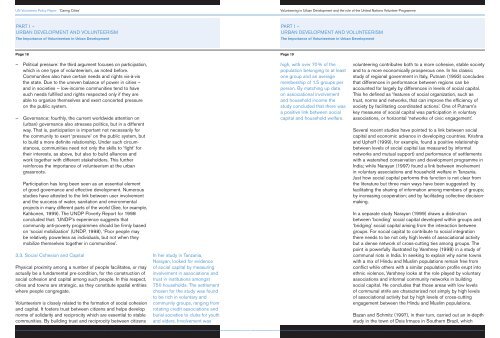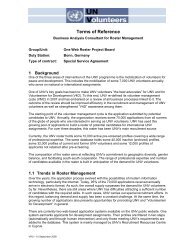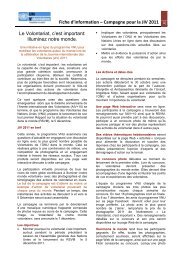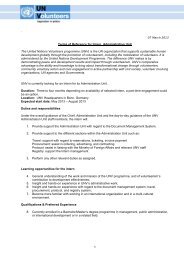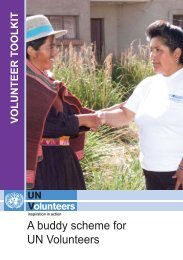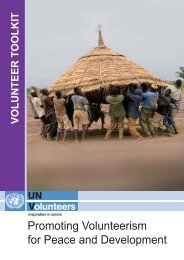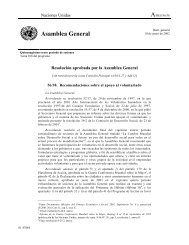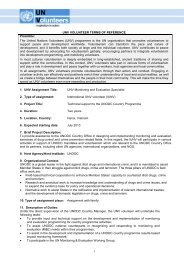View associated PDF document - United Nations Volunteers
View associated PDF document - United Nations Volunteers
View associated PDF document - United Nations Volunteers
You also want an ePaper? Increase the reach of your titles
YUMPU automatically turns print PDFs into web optimized ePapers that Google loves.
UN <strong>Volunteers</strong> Policy Paper<br />
‘Caring Cities’<br />
Volunteering in Urban Development and the role of the <strong>United</strong> <strong>Nations</strong> Volunteer Programme<br />
PART I –<br />
URBAN DEVELOPMENT AND VOLUNTEERISM<br />
The Importance of Volunteerism in Urban Development<br />
PART I –<br />
URBAN DEVELOPMENT AND VOLUNTEERISM<br />
The Importance of Volunteerism in Urban Development<br />
Page 18<br />
Page 19<br />
– Political pressure: the third argument focuses on participation,<br />
which is one type of volunteerism, as noted before.<br />
Communities also have certain needs and rights vis-à-vis<br />
the state. Due to the uneven balance of power in cities –<br />
and in societies – low-income communities tend to have<br />
such needs fulfilled and rights respected only if they are<br />
able to organize themselves and exert concerted pressure<br />
on the public system.<br />
– Governance: fourthly, the current worldwide attention on<br />
(urban) governance also stresses politics, but in a different<br />
way. That is, participation is important not necessarily for<br />
the community to exert ‘pressure’ on the public system, but<br />
to build a more definite relationship. Under such circumstances,<br />
communities need not only the skills to ‘fight’ for<br />
their interests, as above, but also to build alliances and<br />
work together with different stakeholders. This further<br />
reinforces the importance of volunteerism at the urban<br />
grassroots.<br />
Participation has long been seen as an essential element<br />
of good governance and effective development. Numerous<br />
studies have attested to the link between user involvement<br />
and the success of water, sanitation and environmental<br />
projects in many different parts of the world (See, for example,<br />
Kahkonen, 1999). The UNDP Poverty Report for 1998<br />
concluded that: ‘UNDP’s experience suggests that<br />
community anti-poverty programmes should be firmly based<br />
on ‘social mobilization’ (UNDP, 1998), ‘Poor people may<br />
be relatively powerless as individuals, but not when they<br />
mobilize themselves together in communities’.<br />
3.3. Social Cohesion and Capital<br />
Physical proximity among a number of people facilitates, or may<br />
actually be a fundamental pre-condition, for the construction of<br />
social cohesion and capital among such people. In this respect,<br />
cities and towns are strategic, as they constitute spatial entities<br />
where people congregate.<br />
Volunteerism is closely related to the formation of social cohesion<br />
and capital. It fosters trust between citizens and helps develop<br />
norms of solidarity and reciprocity which are essential to stable<br />
communities. By building trust and reciprocity between citizens<br />
In her study in Tanzania,<br />
Narayan, looked for evidence<br />
of social capital by measuring<br />
involvement in associations and<br />
trust in institutions amongst<br />
750 households. The settlement<br />
chosen for the study was found<br />
to be rich in voluntary and<br />
community groups, ranging from<br />
rotating credit associations and<br />
burial societies to clubs for youth<br />
and elders. Involvement was<br />
high, with over 70% of the<br />
population belonging to at least<br />
one group and an average<br />
membership of 1.5 groups per<br />
person. By matching up data<br />
on associational involvement<br />
and household income the<br />
study concluded that there was<br />
a positive link between social<br />
capital and household welfare.<br />
volunteering contributes both to a more cohesive, stable society<br />
and to a more economically prosperous one. In his classic<br />
study of regional government in Italy, Putnam (1993) concludes<br />
that differences in performance between regions can be<br />
accounted for largely by differences in levels of social capital.<br />
This he defined as ‘features of social organization, such as<br />
trust, norms and networks, that can improve the efficiency of<br />
society by facilitating coordinated actions’. One of Putnam’s<br />
key measures of social capital was participation in voluntary<br />
associations, or horizontal ‘networks of civic engagement’.<br />
Several recent studies have pointed to a link between social<br />
capital and economic advance in developing countries. Krishna<br />
and Uphoff (1999), for example, found a positive relationship<br />
between levels of social capital (as measured by informal<br />
networks and mutual support) and performance of settlements<br />
with a watershed conservation and development programme in<br />
India; while Narayan (1997) found a link between involvement<br />
in voluntary associations and household welfare in Tanzania.<br />
Just how social capital performs this function is not clear from<br />
the literature but three main ways have been suggested: by<br />
facilitating the sharing of information among members of groups;<br />
by increasing cooperation; and by facilitating collective decisionmaking.<br />
In a separate study Narayan (1999) draws a distinction<br />
between ‘bonding’ social capital developed within groups and<br />
‘bridging’ social capital arising from the interaction between<br />
groups. For social capital to contribute to social integration<br />
there needs to be not only high levels of associational activity<br />
but a dense network of cross-cutting ties among groups. The<br />
point is powerfully illustrated by Varshney (1998) in a study of<br />
communal riots in India. In seeking to explain why some towns<br />
with a mix of Hindu and Muslim populations remain free from<br />
conflict while others with a similar population profile erupt into<br />
ethnic violence, Varshney looks at the role played by voluntary<br />
associations and informal community networks in building<br />
social capital. He concludes that those areas with low levels<br />
of communal strife are characterized not simply by high levels<br />
of associational activity but by high levels of cross-cutting<br />
engagement between the Hindu and Muslim populations.<br />
Bazan and Schmitz (1997), in their turn, carried out an in-depth<br />
study in the town of Dois Irmaos in Southern Brazil, which


